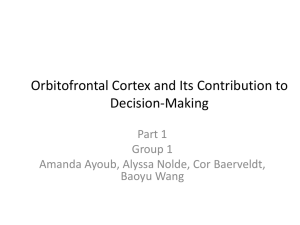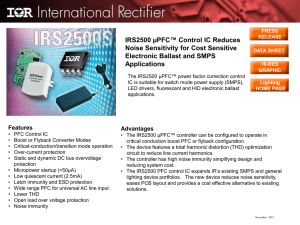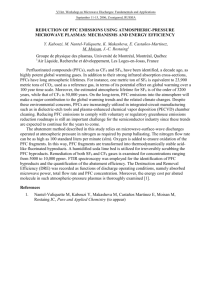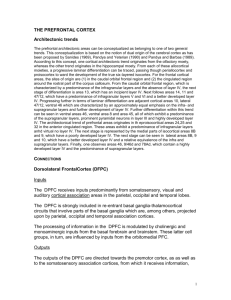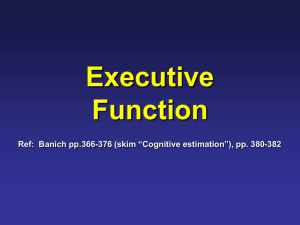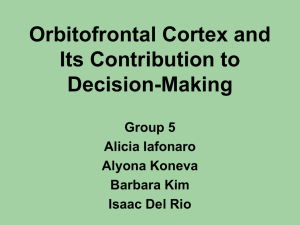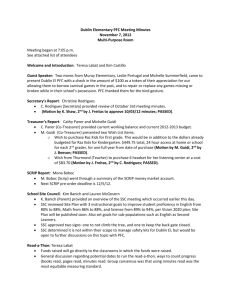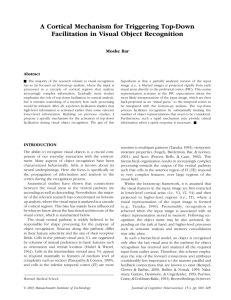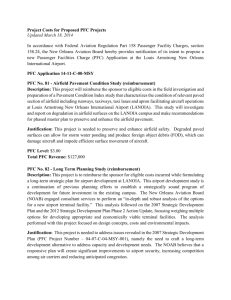Validating the Why/How contrast for functional MRI studies of Theory
advertisement
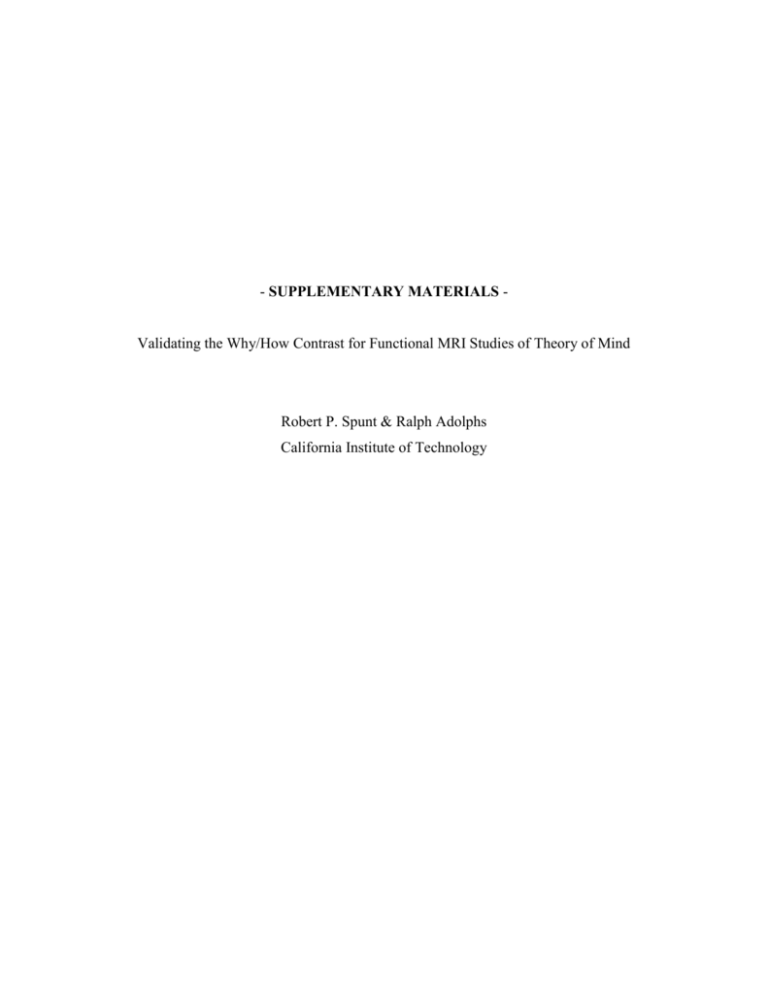
- SUPPLEMENTARY MATERIALS - Validating the Why/How Contrast for Functional MRI Studies of Theory of Mind Robert P. Spunt & Ralph Adolphs California Institute of Technology S1. Supplemental Methods 1.1. Ruling Out Performance-Related Variability in the Why/How Contrast Compared to How questions, Why questions reliably elicit lower response accuracy and longer response times (RT). The analyses reported in the main text were conducted using singlesubject models that include covariates of no interest corresponding to variability in accuracy and RT. In order to verify that this method of control was achieving its intended effect, and to further confirm that performance-related variability cannot explain the neural responses typically observed in the Why/How contrast, we estimated two additional models for each participant. Except for the differences described below, these models including the same nuisance covariates as the models described in the main text, and were estimated using the same procedures. In the first, we took each condition and evenly divided blocks into those eliciting the highest and the lowest accuracy rates. This yielded four regressors corresponding to High and Low Accuracy Why questions, and High and Low Accuracy How questions. Given that blocks were divided based on accuracy, a nuisance covariate corresponding to accuracy rates was not included in these models. Following estimation, we computed a contrast amongst high accuracy Why questions and low accuracy How questions. In the second, we took each condition and evenly divided blocks into those eliciting the fastest and the slowest RTs. This yielded four regressors corresponding to Fast and Slow RT Why questions, and Fast and Slow RT How questions. Given that blocks were divided based on RT, a nuisance covariate corresponding to RT variability was not included in these models. Following estimation, we computed a contrast amongst Fast Why questions and Slow How questions. S2. Supplemental Results and Discussion 2.1. Analyses of Performance Variability in the Why/How Contrast A paired t-test confirmed that participants were more accurate for High Accuracy Why questions (M = 99.185%, SD = 2.000) than for Low Accuracy How questions M = 92.342%, SD = 5.823), t(49) = 7.817, p = 0.000, 95% CI [5.083, 8.601]. Paralleling this effect, a paired t-test confirmed that participants had faster RTs during Fast Why blocks (M = 852 ms, SD = 150 ms) than for Slow How blocks (M = 758 ms, SD = 151 ms), t(49) = 8.011, p = 0.000, 95% CI [0.071, 0.118]. These effects effectively reverse those observed in the main text. Table S2 shows the results of whole-brain comparisons of High Accuracy Why to Low Accuracy How blocks, and of Fast Why to Slow åHow blocks. Both comparisons replicate the results that were observed in both Study 1 and Study 3. This conclusively demonstrates that performance Page 2 variability does not provide a sufficient alternative explanation of the regional brain activity modulated in the Why/How contrast. Moreover, they verify the efficacy of the methods that our primary analyses employed to control for performance-related variability. To be clear, it remains possible that some variance in the Why/How contrast is explained by performance-related effects. This analysis simply shows that these performance-related effects do not provide a sufficient explanation of the effects observed in the Why/How contrast. In future research, it will be worthwhile to systematically examine the source of these behavorial effects, for instance by testing targeted hypotheses about brain-behavior relationships, as well as parametrically manipulating task variables tied to task difficulty. 2.2. Analyses of Functional Lateralization In an effort to increase the precision of our anatomical definition of the Why/How contrast, we tested the contrast for hemispheric lateralization. Table S3 lists regions showing significant functional lateralization in the Why > How contrast based on the pooled data from Study 1 and Study 3 (N = 50). For each participant, we used their Why/How contrast image to calculate a laterality index at each voxel in the entire brain. Positive values indicate stronger responses in the left compared to right hemisphere; a value of zero indicates equivalent responses in the two hemispheres; and negative values indicate stronger responses in the right compared to left hemispheres. Then, we submitted these images to a one-sample t-test to determine those regions demonstrating a statistically meaningful level of functional lateralization. As can be seen from Table S3, the functional anatomy of the Why > How contrast is highly lateralized to the left hemisphere. In fact, of all the cortical regions associated with the Why > How contrast in the three studies, only the posterior cingulate cortex failed to show left hemisphere selectivity. The single region to show evidence of right hemisphere selectivity was in the posterior lobe of the cerebellum. 2.3. Whole-Brain Multivariate Similarity Analysis To evaluate differences in the pairwise similaries across the two Why/How contrasts and the Belief/Photo contrasts for the 10 subjects included in Study 2, we used the Fisher's z-transformed Pearson correlation of the multivariate response pattern across the whole-brain (grey-matter masked). Whereas we observed no evidence for a correlation of the Why/How Localizer with the Belief/Photo Localizer (rmean = 0.17, rsd = 0.18), such a correlation was apparent with Why/How at the first timepoint (rmean = 0.49, rsd = 0.16), and the difference between these two sets of correlations was significant, t(9) = 5.100, p = 0.001, 95% CI [0.176, 0.457]. Figure S3 illustrates this difference using a Page 3 representational dissimilarity matrix (RDM). The dissimilarity metric used is 1 minus the Pearson correlation (r) and ranges from 0 (identical) to 2 (complete anti-correlation). Figure S3 also shows a representation of each participants' response pattern in two-dimensions using Multidimensional Scaling. Page 4 References Grinband, J., Savitskaya, J., Wager, T. D., Teichert, T., Ferrera, V. P., & Hirsch, J. (2011). The dorsal medial frontal cortex is sensitive to time on task, not response conflict or error likelihood. NeuroImage, 57(2), 303-311. doi:10.1016/j.neuroimage.2010.12.027 Grinband, J., Wager, T. D., Lindquist, M., Ferrera, V. P., & Hirsch, J. (2008). Detection of timevarying signals in event-related fmri doi:10.1016/j.neuroimage.2008.07.065 Page 5 designs. NeuroImage, 43(3), 509-520. Table S1 The question used to manipulate attention to why vs. how for actions vs. expressions in Study 2. All questions began with the string “Is the person “. Why Hand Actions How Facial Expressions Hand Actions Facial Expressions competing against others? being affectionate? carrying something? gazing up? doing their job? celebrating something? lifting something up? looking at the camera? expressing themselves? expressing gratitude? putting something on? looking to the side? helping someone? expressing self-doubt? reaching for something? opening their mouth? protecting themselves? in an argument? using a writing utensil? showing their teeth? sharing knowledge? proud of themselves? using both hands? smiling? Page 6 Table S2 Analyses that test the hypothesis that the network observed in the Why > How contrast is explained by differences in mean response time (RT) or accuracy in the two conditions. Each contrast was estimated using a separate model. The first compares high accuracy Why blocks and low accuracy How blocks, while the second compares the fastest Why blocks to the slowest How blocks. Results are based on pooled data from Study 1 and Study 3 (N = 50). All peaks survive a whole-brain search thresholded at a voxel-wise family-wise error rate of .05 and a cluster extent (k) of at least 10 voxels. PFC = Prefrontal Cortex; OFC = Orbitofrontal Cortex; STS = Superior Temporal Sulcus; x, y, and z = Montreal Neurological Institute (MNI) coordinates in the left-right, anterior-posterior, and inferiorsuperior dimensions, respectively. Contrast Name Region Name L/R k t-value Why (High Accuracy) > How (Low Accuracy) Dorsomedial PFC L 2926 12.714 L 8.404 R 6.288 Ventromedial PFC L/R 9.877 Lateral OFC L 256 7.607 Temporoparietal Junction L 270 7.658 Posterior Cingulate Cortex L 516 10.644 Posterior STS L 86 7.079 Anterior STS L 311 8.794 R 138 7.634 Temporal Pole R 57 6.934 Why (Fastest) > How (Slowest) Dorsomedial PFC Ventromedial PFC Lateral OFC Temporoparietal Junction Posterior Cingulate Cortex Anterior STS Temporal Pole L 1586 12.366 L 6.042 R 21 5.809 L/R 330 7.992 L 56 7.009 L 83 7.307 L 385 10.318 L 226 8.133 R 13 5.869 R 19 6.690 Page 7 MNI Coordinates x y z -4 -8 16 0 -46 -42 -2 -58 -52 60 46 58 28 42 56 26 -62 -56 -30 -4 -4 14 28 60 42 -14 -6 30 32 -4 -20 -16 -32 -6 -8 8 0 -42 -44 -4 -62 52 48 60 26 50 46 22 -62 -54 -10 -2 8 26 62 42 -18 -14 28 32 -18 -22 -30 Table S3 Regions showing significant functional lateralization in the Why > How contrast based on the pooled data from Study 1 and Study 3 (N = 50). Clusters were defined using a voxel-wise thresholded of p < .001, and all reported clusters survive cluster-level correction at a family-wise error rate of .05. PFC = Prefrontal Cortex; OFC = Orbitofrontal Cortex; STS = Superior Temporal Sulcus; x, y, and z = Montreal Neurological Institute (MNI) coordinates in the left-right, anterior-posterior, and inferiorsuperior dimensions, respectively. MNI Coordinates Region Name Dorsomedial PFC L/R k t-value x y z L 1605 10.954 -6 60 38 - 6.550 -10 38 52 - 4.037 -20 62 12 Ventromedial PFC L 239 5.459 -6 40 -14 Lateral OFC L 940 6.804 -46 20 -12 Temporoparietal Junction L 710 6.556 -48 -72 36 Temporal Pole L 84 5.799 -44 6 -36 Anterior STS L 383 6.992 -64 -14 -8 Posterior STS L 94 4.755 -58 -46 2 Dorsolateral PFC L 224 5.641 -34 22 50 Cerebellum (Posterior Lobe) R 324 6.448 34 -78 -34 Page 8 Figure S1 Design of the False-Belief Localizer. Each row shows actual stimuli and timing for the Story and Judgment elements of the Belief and Photo conditions. Page 9 Figure S2 Dissimilarity analysis of the whole-brain (grey-matter masked) multivariate response patterns produced by the Why/How and Belief/Photo contrasts. This supplements panels (b) and (c) of Figure 3, which shows the same analysis within a meta-analytically defined mask of the Theory-of-Mind Network. (a) A representational dissimilarity matrix (RDM) showing the degree of pairwise dissimilarity among the three contrasts estimated for each of the ten participants: the Why/How contrast from Study 1 (rows/columns 1-10; Why/HowS1); the Why/How contrast from Study 2 (rows/columns 11-20; Why/HowS2); and the Belief/Photo contrast (rows/columns 21-30). The dissimilarity metric is 1 minus the Pearson correlation (r), where a value of 0 indicates perfect correlation; 1 indicates non-correlation; and 2 indicates perfect anti-correlation. Because the order of participants is constant across the three blocks of contrasts, the diagonals within each block represent within-subject pattern dissimilarities, while the off-diagonals represent between-subject dissimilarities. (b) A two-dimensional representation of the similarity structure based on multidimensional scaling applied to the RDM. Each colored circle represents a single contrast image, and constrast images for the same participant are connected by dashed colored lines. The length of these lines is the Euclidean distance between them, with longer lines representing more dissimilar multivariate patterns. Page 10

